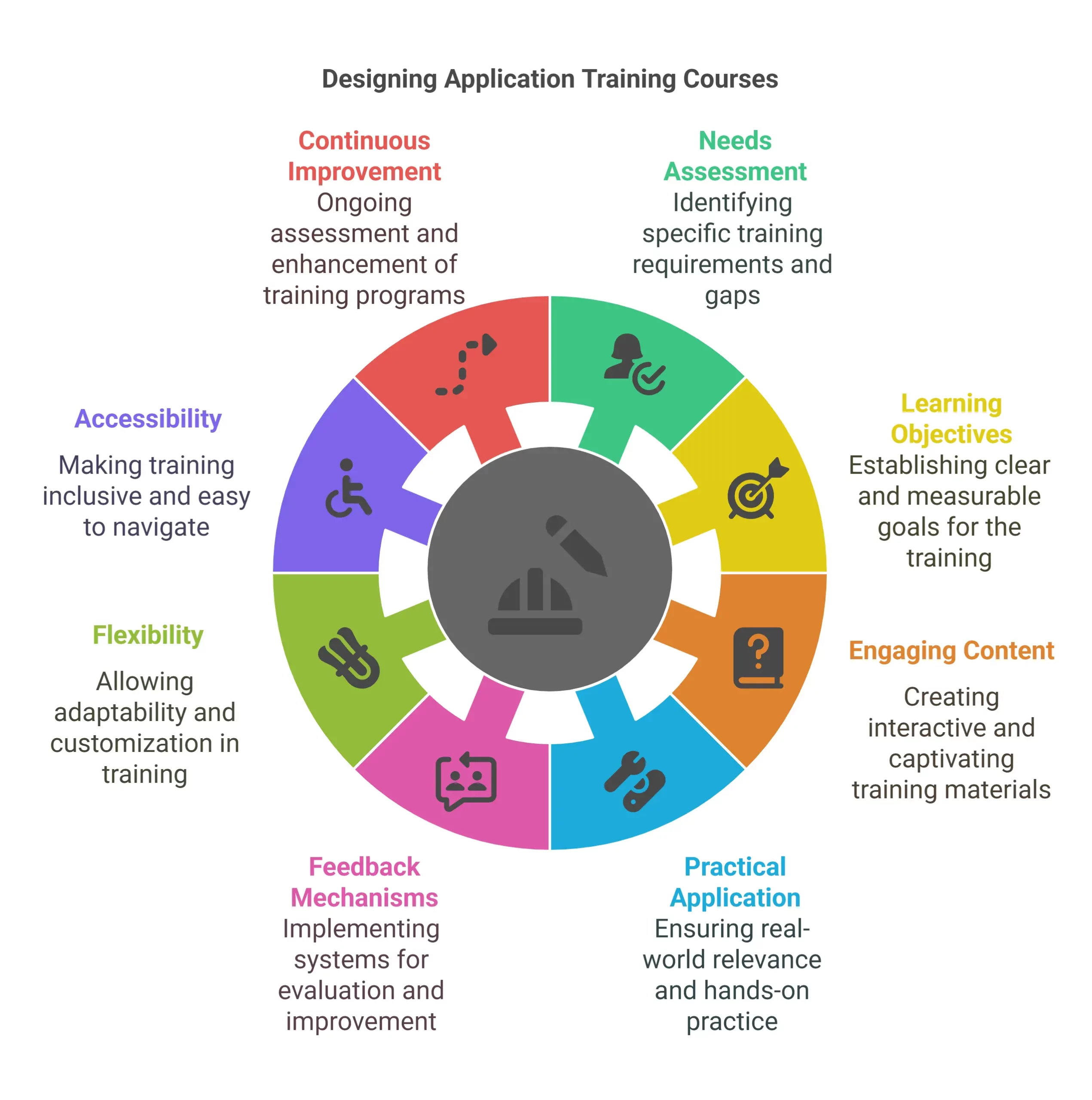
Designing Application Training That Boosts Your IT Team Performance
Summary
Boost your IT team’s performance with effective application training! This blog explores best practices for designing engaging, hands-on training programs that enhance skills, improve efficiency, and drive productivity. Learn how tailored training solutions can empower your team to master new technologies and stay ahead in the digital era.
In the rapidly evolving landscape of Information Technology, staying ahead of the curve is crucial for IT professionals. With new trends in IT emerging at an unprecedented pace, keeping one’s skills up-to-date has become more critical than ever. This is where Application Training plays a pivotal role.
In this blog, we’ll delve into the significance of Application Training, explore its current trends, and gaze into the crystal ball to discern the future trends in IT Corporate Training for IT Professionals.
Table of Contents:
- What is Application Training?
- Why is Effective Application Training Important for IT Companies?
- Is it Easy to Design Effective Application Training Courses for the IT Workforce?
- 8 Key Considerations for Designing Application Training Courses for IT Companies
- Current Trends in Application Training for IT Professionals
- Future Trends in Application Training for IT Professionals
- Conclusion
What is Application Training?
Application Training is a specialized form of IT Corporate Training designed to equip employees with the skills and knowledge required to use specific software applications proficiently. IT training programs can range from basic office productivity tools to complex enterprise-level software suites. IT company training aims to enhance IT skills, ensuring optimal utilization of software resources within an organization.
Why is Effective Application Training Important for IT Companies?
Before diving into the nitty-gritty of crafting a stellar IT Company Training program, let’s first understand why it is paramount.
1. Skill Enhancement and Adaptability
In the dynamic realm of Information Technology, adaptability is the key to survival. Regular application training equips employees with the latest skills, making them agile in responding to technological shifts and advancements.
2. Increased Productivity and Efficiency
Well-structured IT Training Solutions empower employees to use applications to their full potential. This boosts their productivity and ensures that projects are executed efficiently, meeting deadlines precisely.
3. Reduced Downtime and Support Costs
A workforce well-versed in their applications is less likely to encounter operational hiccups, minimizing downtime and reducing the need for constant IT support. There is a reduced need for supervision as well.
4. Enhanced Job Satisfaction and Retention
Offering comprehensive IT Corporate Training programs signals to employees that their professional growth is a priority. This fosters a sense of loyalty and job satisfaction, leading to higher retention rates.
5. Competitive Edge in the Market
An adept workforce is a valuable asset in the competitive IT industry. Effective application training sets your company apart by ensuring your team is equipped with the latest skills and knowledge.
Is it Easy to Design Effective Application Training Courses for the IT Workforce?
Designing effective application training courses for IT professionals requires a nuanced approach. It’s not merely about disseminating information; it’s about ensuring that the knowledge is absorbed and applied in a practical context. This demands a deep understanding of the subject matter and expertise in instructional design and adult learning principles.
Let us look at eight important aspects to consider while designing application training courses for IT companies.
8 Key Considerations for Designing Application Training Courses for IT Companies
1. Accurate Needs Assessment:
A thorough needs assessment is crucial before designing a course. This involves identifying the specific skills and knowledge gaps within the IT workforce and the particular product/software knowledge and competencies that must be imparted. Understanding the unique requirements of the learners ensures that the training program is tailored to address those precise needs.
2. Clear Learning Objectives:
Define clear, specific, and actionable learning objectives for the course. SMART objectives, that is, Specific, Measurable, Achievable, Relevant, and Time-bound objectives, can provide a solid framework for designing application training programs. These objectives are predetermined, measurable outcomes the trainees should achieve at the end of a training program. Therefore, they serve as a roadmap, guiding the instructional design process and the learners’ progress throughout the training program.
Typically, objectives are knowledge-based (impart knowledge, facts, etc.), skill-based (focus on practical abilities and competencies), or attitude-based (shape attitudes and beliefs around aspects of work). Determining the nature and type of objectives will help design the course. Ideally, the course should empower all types of learners: visual, auditory, and kinesthetic.
3. Engaging Content and Instructional Methods:
The content and instructional methods must be engaging and interactive to capture the attention and maintain the interest of IT professionals. Incorporate a variety of media, such as video tutorials, simulations, and hands-on exercises. Online training videos, eLearning, and blended learning (which combines online independent learning with virtual instructor-led learning) will prove to be both efficient and cost-effective.
Adaptive learning features that enable trainees to begin training at the level appropriate for their knowledge and skills and gamification, with dynamic interfaces, rules, level badges, and leaderboards that track progress, can attract and engage trainees and enhance knowledge retention because multiple senses are involved.
4. Practical Application
Application training thrives on hands-on experiences. Provide opportunities for learners to apply their knowledge in realistic scenarios. This allows trainees to make mistakes in a safe environment and makes room for course correction. This also reinforces their understanding and builds confidence in using the application effectively. Practical application also gives trainees more control over what they learn, which is a huge positive for trainees.
5. Feedback and Assessment
Regular feedback and assessments are integral to a successful training program. They offer insights into the learners’ progress and enable necessary adjustments to the course content or delivery methods. Periodic tests, online assessments, projects, and quizzes are typical ways of gauging the trainees’ retention and tracking their progress. They also indicate areas for improvement the trainer can address seamlessly, all this while motivating the learners all the way.
6. Flexibility and Adaptability
The IT landscape is dynamic, with new tools and technologies emerging frequently. Design the training program with flexibility in mind, allowing for updates and adaptations to cater to evolving needs.
7. Accessibility and User-Friendliness
Ensure that the training materials and platform are accessible to all learners, regardless of their level of expertise. A user-friendly interface and clear navigation contribute to a seamless learning experience. The program should be accessible to all types of learners: visual (who read and absorb content), auditory (who listen and learn), and kinesthetic (who learn through hands-on practice) using multiple types of devices (mobile phone, tablet, laptop).
8. Continuous Evaluation and Improvement
The journey doesn’t end with completing the training program. Continuously evaluate its effectiveness through feedback, pre-and post-training assessments, job application (of the training), and performance metrics. Use this information to make improvements for future iterations. When the objectives are clear and measurable, the effectiveness of training – in terms of the development of skills, gain in knowledge, and change in attitude – will become evident.
Current Trends in Application Training for IT Professionals
1. Personalized Learning Paths: Tailoring training programs to IT professionals’ specific needs and skill levels is gaining traction. This approach ensures that professionals can focus on areas where they need the most improvement, optimizing their learning experience.
2. Immersive Learning Experiences: Integrating immersive technologies like Virtual Reality (VR) and Augmented Reality (AR) transforms how IT professionals learn. These technologies provide hands-on, interactive experiences, allowing learners to simulate real-world scenarios.
3. Microlearning Modules: Bite-sized, easily digestible modules are becoming increasingly popular. IT professionals can absorb information more efficiently, fitting learning into their busy schedules. IT professionals use platforms like LinkedIn Learning and Udemy, which offer short, focused courses that can be completed in a few hours or days, allowing for continuous skill development.
4. Gamification Elements: Incorporating gamification elements, such as leaderboards, badges, and challenges, into training programs enhances engagement and motivation. It transforms learning from a chore into an enjoyable experience. Gamified learning apps and platforms like Duolingo and Codecademy make IT training more engaging by incorporating game elements like points, badges, and challenges.
Future Trends in Application Training for IT Professionals
Predicting new trends in application training for IT professionals involves some speculation, but based on the trajectory of the industry, here are some potential future trends:
1. AI-Powered Learning Platforms: AI and machine learning algorithms will personalize learning experiences, providing tailored content and recommendations based on individual learning styles and progress. Advanced algorithms will analyze a professional’s performance and adapt the training content accordingly, ensuring maximum efficacy.
2. Extended Reality (XR) and Immersive Training: Integrating Extended Reality, encompassing VR, AR, and Mixed Reality (MR) technologies, will become more commonplace. IT professionals can immerse themselves in virtual environments, gaining hands-on experience without physical equipment.
3. Blockchain and Decentralized Learning Records: Blockchain technology may create secure, verifiable records of an IT professional’s certifications and achievements, allowing for more transparent and reliable credentialing. It will also provide safe, tamper-proof accreditation of skills and credentials. This will enhance trust and transparency in the certification process, benefiting both professionals and employers.
4. Quantum Computing Training: As quantum computing advances, specialized training programs will be developed to equip IT professionals with the skills needed to work in this emerging field.
5. Edge Computing and IoT Training: With the proliferation of edge computing and IoT devices, training will focus on managing and securing decentralized computing environments.
6. Natural Language Processing (NLP) and Conversational AI: Training programs will emphasize skills in building and deploying applications that leverage NLP and conversational AI for customer service, virtual assistants, and more.
7. Ethics and Responsible AI Training: Given the ethical implications of AI and automation, there will be a growing emphasis on training IT professionals to develop and deploy technologies ethically.
8. Cybersecurity and Threat Intelligence: As cyber threats continue to evolve, training in IT companies is bound to involve specialized training in threat intelligence, incident response, and advanced cybersecurity techniques will be in high demand.
9. No-Code/Low-Code Development Platforms: Training programs will focus on enabling IT professionals to leverage no-code/low-code platforms for rapid application development, allowing for quicker prototyping and deployment.
10. Green IT and Sustainable Technology Practices: With a growing emphasis on sustainability, training will incorporate best practices for designing and managing IT systems with minimal environmental impact.
11. DevSecOps and Secure Development Lifecycle (SDLC): Training will emphasize integrating security practices throughout the software development lifecycle, ensuring security is a fundamental consideration from the outset.
12. Multi-Cloud and Hybrid Cloud Management: Training programs will address the challenges and opportunities of managing applications across multiple cloud providers and hybrid environments.
13. Data Privacy and Compliance Training: Given the increasing importance of data privacy regulations (e.g., GDPR, CCPA), training will focus on compliance, data protection, and privacy-by-design principles.
14. Soft Skills and Leadership Development: As IT professionals take on more leadership roles, training will expand to include communication, teamwork, and management skills.
15. Continuous Learning and Upskilling Initiatives: Lifelong learning will become a cornerstone of IT professional development, with organizations supporting ongoing training and upskilling efforts. The future of IT training programs will shift towards continuous learning ecosystems. This means that learning will be an ongoing, integrated part of an IT professional’s career, with access to resources, mentors, and updated content readily available.
Remember, these are projections based on today’s tech trends and technologies. The actual future of IT application training will depend on how the industry evolves and the specific needs that emerge over time. Keeping an eye on industry publications, attending conferences, and participating in professional communities will help IT professionals stay at the forefront of these trends.
Conclusion
Application Training is the cornerstone of IT skills enhancement, enabling your workforce to harness the full potential of software applications. By carefully selecting the right training program, you are investing in the growth and success of your IT company. Remember, a well-trained workforce is a competitive advantage in today’s rapidly evolving tech landscape.
As we step into a future propelled by cutting-edge technologies, the landscape of IT Corporate Training is set to transform. Embracing these trends in Application Training will be paramount for IT professionals aiming to thrive in this dynamic industry. To embark on this journey towards future-ready IT skills, consider exploring the innovative solutions Hurix Digital offers. Their forward-thinking approach to digital learning ensures that IT professionals have the latest knowledge and expertise to stay ahead of the curve.
Contact Hurix Digital to discover more about how we can revolutionize your IT training experience. Stay ahead of the tech curve with the leaders in digital learning!

A highly enthusiastic and motivated sales professional with over twenty five years of experience in solution selling of training-related applications and services. Maintains an assertive and dynamic style that generates results. Ability to establish long-term relationships with clients built on trust, quality of service and strategic vision. Specializes in financial services, higher ed, publishing and government in the areas of learning and development.


























